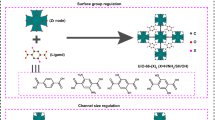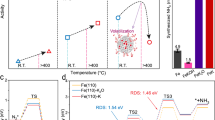Abstract
SINCE the muscle membrane is permeable to the ammonium ion, from the theory of potassium equilibria previously described1,2, the following should hold: where a,a1, k,k1 and h,h1 are the concentrations of ammonium, potassium and hydrogen ions outside and inside the membrane. On investigation, it appeared that the ammonium ion (or possibly the minute amount of associated free base) has a marked effect on the membrane itself, all ratios being lowered across it (Fenn and Cobb have described such an effect of ammonia on potassium3).
This is a preview of subscription content, access via your institution
Access options
Subscribe to this journal
Receive 51 print issues and online access
$199.00 per year
only $3.90 per issue
Buy this article
- Purchase on SpringerLink
- Instant access to full article PDF
Prices may be subject to local taxes which are calculated during checkout
Similar content being viewed by others
References
Conway, E. J., and Boyle, P. J., NATURE, 144. 709 (1939).
Boyle, P. J., and Conway, E. J., J. Physiol., 100, 1 (1941).
Fenn, W. O., and Cobb, D. M., J. Gen. Physiol., 17, 629 (1934).
Author information
Authors and Affiliations
Rights and permissions
About this article
Cite this article
CONWAY, E., O'BRIEN, M. & BOYLE, P. Interchange of the Ammonium and Potassium Ions in Muscle and Yeast. Nature 148, 662 (1941). https://doi.org/10.1038/148662a0
Issue date:
DOI: https://doi.org/10.1038/148662a0
This article is cited by
-
Activity and regulation of an amidase (acylamide amidohydrolase, EC 3.5.1.4) with a wide substrate spectrum from a Brevibacterium sp.
Archives of Microbiology (1984)
-
Rate of Entrance of Ammonia into Muscle Fibres in Relation to Carbon Dioxide Tension
Nature (1945)
-
Potassium, Fermentation and the Cell Membrane
Nature (1942)



